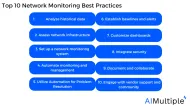Top 5 WAN Monitoring Software in 2024 based on 800+ Reviews


Reliable WAN performance is critical to business operations, and efficient WAN monitoring software is important to ensure stability and performance. In this vendor selection guide, we will provide information and comparison of popular WAN monitoring software.
What are the top 5 WAN monitoring software?
| Vendors | # of employees | # of B2B reviews | Average rating |
|---|---|---|---|
| AKIPS | 15 | 4 | 4.7/5 |
| ManageEngine Site24x7 | 302 | 449 | 4.6/5 |
| Paessler PRTG | 364 | 279 | 4.6/5 |
| SolarWinds VoIP & Network Quality Manager | 2400 | 13 | 4.4/5 |
| ThousandEyes | 883 | 81 | 4.5/5 |
* Vendors are ordered alphabetically.
Selection criteria
We narrowed down our WAN monitoring tools comparison focusing on three main factors:
- Number of employees: We looked at vendors with 15+ employees on LinkedIn.
- Number of user reviews: We included solutions with at least 4 user reviews from the popular B2B review websites (such as G2 and Capterra), as it indicates a level of market presence and user experience.
- Average review ratings: We selected the vendors with at least 4.4 points on average.
Review of Top 5 WAN Monitoring Software
1- AKIPS
AKIPS Network Monitor is a network performance monitoring tool that serves WAN monitoring. It highlights its capability to handle large-scale networks and fast polling intervals.
Pros
- Efficient Monitoring: Handles large networks effectively with optimized processes for SNMP information mining.
- Ease of Setup and Use: Noted for its easy setup and the ability to integrate into various environments.
- Customization and Reporting: Offers customizable features and robust reporting capabilities.
Cons
- User Interface: The GUI is not very user-friendly, especially for non-technical users, and lacks an integrated network map (See Figure below).
Figure 1. Customer review on AKIPS1
2- ManageEngine Site 24×7
Site24x7 is a cloud-based monitoring solution designed to monitor the performance of websites, online applications, servers, and internet services. It also offers WAN monitoring as a feature.
Pros
- Comprehensive Monitoring Solutions: Reviews consistently praise Site24x7 for its extensive range of monitoring options, providing a “one-stop shop” for various needs such as server monitoring, application performance, and real-time alerts. This wide array of features allows users to monitor diverse IT equipment and systems efficiently within a single platform.
- Ease of Integration and Deployment: Users appreciate the platform’s ease of integration with existing infrastructure and the straightforward deployment process. The availability of necessary plugins out-of-the-box and compatibility with different IT equipment enhances the user experience by simplifying the setup.
- Cost-Effectiveness: Many reviews highlight the attractive price point of Site24x7, especially for smaller installations. Users feel that the service offers good value for money, allowing for extensive monitoring capabilities without a significant financial burden.
Cons
- Complexity and Documentation Issues: Some users find the platform overwhelming due to the sheer number of options available. The complexity is compounded by documentation that is sometimes lacking in clarity, particularly regarding manual configurations and advanced features. This can make it challenging for users to fully leverage the platform’s capabilities or customize it to their specific needs without additional guidance or support (see Figure below).
Figure 2. User review on Site24x72
3- PRTG
PRTG is an IT monitoring tool that helps businesses monitor their entire network infrastructure on-premises, cloud, or hybrid environment, together with WAN monitoring.
Pros
- Versatility and Comprehensive Monitoring: Many users appreciate the wide variety of areas that PRTG can monitor, including applications, cloud services, dedicated servers, databases, websites, and server services. This versatility allows for a holistic view of an organization’s IT infrastructure.
- Alerts and Real-time Monitoring: Users highly value the alerting capabilities of PRTG, which enables them to receive notifications via email for device downtimes and other critical issues. This feature is particularly appreciated for its contribution to maintaining high uptime by allowing immediate response to issues.
- Ease of Use and Configuration: The ability to easily manage, configure, and customize monitoring according to specific needs is frequently mentioned. Features like templating devices for easier deployment across similar servers and the user-friendly interface make PRTG accessible for both beginners and experienced users.
Cons
- Learning Curve and Complexity: Despite its versatility and ease of use, some users note that fully exploring and learning all the features of PRTG can be time-consuming due to its extensive capabilities. This is not necessarily a drawback but rather an observation that getting up to speed with all aspects of the tool might require a significant investment of time (see Figure below)
Figure 3. User review on PRTG3
SolarWinds VoIP & Network Quality Manager
SolarWinds provides real-time historical network performance and call quality statistics to quickly identify issues and take steps to resolve them. The product also offers WAN monitoring as a part of network visibility.
Pros
- Ease of Use and Configuration: Many users appreciate the ease of use and simple configuration of SolarWinds VoIP & Network Quality Manager. The interface is mentioned as being user-friendly, which facilitates monitoring and management tasks.
- Monitoring Capabilities: Users highly value the tool’s ability to monitor various aspects of the network and VoIP services, such as call quality, network performance, and real-time WAN monitoring. The versatility in monitoring different network parameters is a significant advantage.
- Alerts and Real-Time Monitoring: The alerting capabilities of SolarWinds VoIP & Network Quality Manager are frequently praised. Users find the real-time monitoring and alert management features helpful for maintaining network performance and addressing issues promptly.
Cons
- Interface and Feature Enhancements Needed: Several users pointed out that the Graphical User Interface (GUI) could be improved by adding more features and making it more intuitive. There’s also a call for security features to be added and for the overall user interface to be updated to enhance user experience (see Figure below).
Figure 4. User review on SolarWinds VoIP & Network Quality Manager4
Cisco ThousandEyes
Cisco ThousandEyes monitors network infrastructure, troubleshoots application delivery, monitors WAN and maps internet performance from a SaaS-based platform.
Pros
- Network Visibility: Users appreciate ThousandEyes for its ability to provide a complete overview of the network path, including visibility into the cloud, Internet routing, WAN, ISP, and service provider infrastructures. This comprehensive visibility helps in identifying and diagnosing network issues effectively.
- Efficiency and Flexibility: The efficiency and flexibility of ThousandEyes in analyzing the performance of local and wide area networks are highly valued. Users find the tool effective in monitoring and analyzing network strength, which aids in proactive network management.
- Data and Client Perspective Monitoring: The depth of data and insights provided by ThousandEyes, especially from the client’s perspective, is considered invaluable. The ability to monitor network and application availability with such granularity helps users understand and improve the digital experience for their users.
Cons
- User Interface and Usability Issues: Several users have pointed out that the UI seems dated and not user-friendly, with some finding it congested and difficult to navigate without training. This suggests that while the tool is powerful, its user interface could be improved to enhance the user experience and make it more intuitive.
Figure 5. User review on ThousandEyes5
What is WAN monitoring?
WAN monitoring, or Wide Area Network monitoring, involves overseeing the performance and reliability of a network that spans a large geographical area, such as a city, country, or even continents. This type of monitoring is essential for businesses and organizations that rely on network connectivity to link multiple locations, data centers, and cloud services.
Key aspects of WAN monitoring include:
- Performance Monitoring: Tracking various metrics such as bandwidth usage, latency (delay in data transmission), packet loss (data that never reaches its destination), and jitter (variance in time it takes for packets to travel). These metrics help in understanding the quality of the network connection.
- Fault Management: Detecting and diagnosing network issues to minimize downtime. This involves identifying failed devices or links, troubleshooting problems, and implementing solutions to restore connectivity.
- Configuration Management: Keeping track of network device configurations and ensuring they are optimized for performance. This can also involve updating configurations to adapt to network changes or to enhance security.
- Security Monitoring: Protecting the network from external threats such as hacking, phishing, and malware attacks. This involves monitoring for suspicious activity and ensuring that firewalls and other security measures are up to date and effective.
- Traffic Analysis: Analyzing the types of traffic flowing over the network to identify usage patterns, bandwidth hogs, and potential security threats. This can help in capacity planning and ensuring that critical applications have the necessary resources.
What is the difference between WAN monitoring and network monitoring?
WAN monitoring is a specialized area within the broader scope of network monitoring, focusing specifically on overseeing the performance and reliability of Wide Area Networks that connect geographically dispersed locations of an organization. While network monitoring encompasses the entire network infrastructure, including LANs, servers, and applications, WAN monitoring zeroes in on long-distance network connections, addressing unique challenges such as higher latency, packet loss, and bandwidth management.
This specialization is crucial for ensuring seamless communication and data transfer across different sites and cloud services, making WAN monitoring an integral part of the overall network monitoring strategy to maintain optimal network performance and reliability.
What are some WAN challenges?
Some common WAN challenges include:
- Network bottlenecks that slow down data flow
- Network failures that bring operations to a halt
- Security breaches that compromise data integrity
- Compatibility issues between different network components
- Configuration errors that lead to network instability
Effective troubleshooting and resolution processes are key to overcoming these challenges and maintaining network integrity.
But what about the specific routing issues and internet outages that impact application performance over the WAN? That’s where SD-WAN monitoring tools come in. These tools offer understanding of these issues, similar to how a GPS gives insights into traffic conditions, enabling efficient management of application performance.
How to enhance visibility across network infrastructure with WAN monitoring?
WAN monitoring software offers comprehensive visibility vital for understanding network performance and pinpointing potential bottlenecks.
But network visibility isn’t just about performance insights. It’s also a crucial component in cybersecurity. Integration with cybersecurity tools enhances WAN monitoring solutions by offering advanced threat detection and response capabilities within the network.
Plus, correlated visibility into both the network underlay and overlay paths is crucial for understanding and ensuring application performance, especially in SD-WAN environments.
1- Mapping the entire network
Automated network topology mapping in WAN monitoring solutions serves as your guide, dynamically updating to mirror changes and preserve an accurate depiction of the network.
For instance, WAN monitoring solutions provide comprehensive dashboards that represent edge locations, transit gateways, devices, and sites on a global map, offering a visual perspective of the network topology. They also furnish detailed views of network components along with logical relationships, providing a structured overview of the global network.
Whether you’re managing an enterprise network or a distributed one, comprehensive monitoring platforms are necessary to provide visibility into every aspect of the network, including the performance of physical and virtual servers, WAN links, and cloud-based services.
2- Real-time monitoring for immediate action
In the world of network management, time is important. Real-time network monitoring tools facilitate the assessment of availability and performance of mission-critical services, guaranteeing swift resolution of operational and configuration issues.
Real-time WAN monitoring provides:
- Real-time data analysis that offers visibility to resolve most of the network issues, emphasizing the importance of live traffic monitoring
- Anomaly detection using machine learning to identify unusual patterns in network performance, which could indicate emerging problems
- Advanced alerting mechanisms that categorize alerts by severity, allowing network administrators to prioritize their response efforts effectively.
3- Reporting and analytics
Detailed reporting aids in long-term network planning and daily operations management via visualization and analysis of network telemetry data like IP flows and raw packets.
Predictive alerting features use historical data to foresee potential issues, and advanced analytics in WAN monitoring software provide bandwidth forecasting, which helps in planning for network capacity expansion. Real-time and historical data visualizations presented in dashboard reports are crucial for immediate insights and informed trend analysis, assisting network administrators in decision-making.
Customizable dashboards and reports provide valuable insights into network performance and trends, offering end-to-end visibility for performance benchmarking and application scoring. These insights are based on detailed performance metrics, ensuring accurate analysis of network performance.
How to select the right WAN monitoring tool for your business?
Choosing the appropriate WAN monitoring tool parallels selecting the right pair of shoes. Factors such as size (your network’s scale), style (your business’s specific needs), and comfort (the tool’s usability) must be considered.
While choosing the right solution, you should consider:
- Your Network Needs and Scale: Whether you’re a small business or a large enterprise, the scale of your network and the size of your business play a crucial role in the selection process. Small businesses need user-friendly, immediate alert systems, while enterprises require comprehensive, scalable solutions.
- Feature Sets and Usability: Contrasting feature sets and usability of various WAN monitoring tools is akin to trying on diverse pairs of shoes to discover the optimal fit. Above we explained the key features to look for. However, you should check the solutions in detail to assess whether they accommodate your specific needs.
- Support and Community Feedback: Reliable technical support from the provider is essential for addressing complex network issues and minimizing downtime. The vendor’s reputation for customer service significantly affects overall satisfaction with the product and support during critical situations. Community feedback and user reviews provide valuable insights into the tool’s real-world performance and reliability. The vendors in our articles are reliable in this respect.
If you have questions or need help in finding vendors, feel free to reach out:
Transparency Statement: AIMultiple works with B2B tech vendors, including AKIPS. Vendors with links are among AIMultiple’s sponsors.
External Links
- 1. “AKIPS Pricing, Alternatives & More 2024.” Capterra. Accessed 19 February 2024.
- 2. “Site24x7 Reviews 2024: Details, Pricing & Features.” G2. Accessed 19 February 2024.
- 3. “PRTG Network Monitor Reviews 2024: Details, Pricing & Features.” G2. Accessed 19 February 2024.
- 4. “SolarWinds VoIP & Network Quality Manager Reviews 2024: Details, Pricing & Features.” G2. Accessed 19 February 2024.
- 5. “ThousandEyes Reviews 2024: Details, Pricing & Features.” G2. Accessed 19 February 2024.

Cem has been the principal analyst at AIMultiple since 2017. AIMultiple informs hundreds of thousands of businesses (as per similarWeb) including 60% of Fortune 500 every month.
Cem's work has been cited by leading global publications including Business Insider, Forbes, Washington Post, global firms like Deloitte, HPE, NGOs like World Economic Forum and supranational organizations like European Commission. You can see more reputable companies and media that referenced AIMultiple.
Throughout his career, Cem served as a tech consultant, tech buyer and tech entrepreneur. He advised businesses on their enterprise software, automation, cloud, AI / ML and other technology related decisions at McKinsey & Company and Altman Solon for more than a decade. He also published a McKinsey report on digitalization.
He led technology strategy and procurement of a telco while reporting to the CEO. He has also led commercial growth of deep tech company Hypatos that reached a 7 digit annual recurring revenue and a 9 digit valuation from 0 within 2 years. Cem's work in Hypatos was covered by leading technology publications like TechCrunch and Business Insider.
Cem regularly speaks at international technology conferences. He graduated from Bogazici University as a computer engineer and holds an MBA from Columbia Business School.
To stay up-to-date on B2B tech & accelerate your enterprise:
Follow on

Comments
Your email address will not be published. All fields are required.